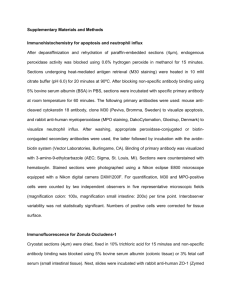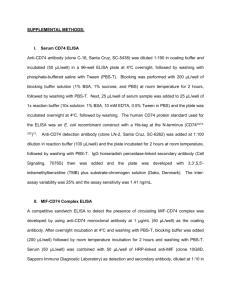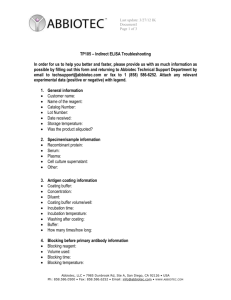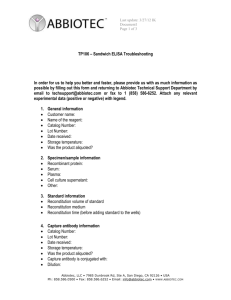Supplementary Materials and Methods
advertisement
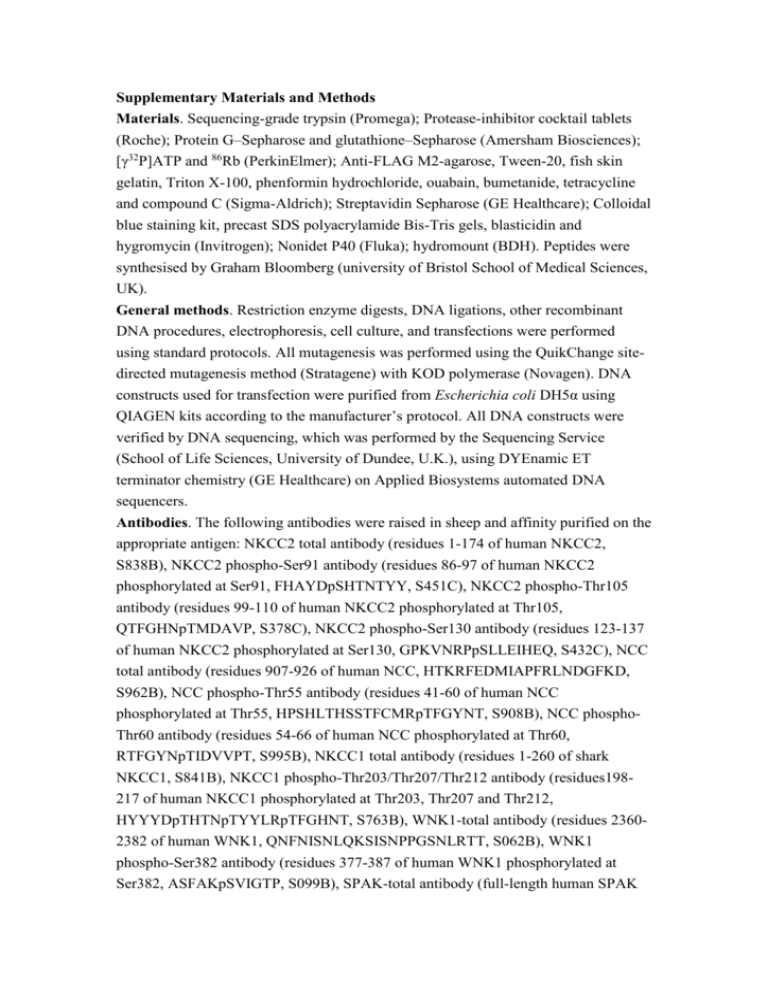
Supplementary Materials and Methods Materials. Sequencing-grade trypsin (Promega); Protease-inhibitor cocktail tablets (Roche); Protein G–Sepharose and glutathione–Sepharose (Amersham Biosciences); [γ32P]ATP and 86Rb (PerkinElmer); Anti-FLAG M2-agarose, Tween-20, fish skin gelatin, Triton X-100, phenformin hydrochloride, ouabain, bumetanide, tetracycline and compound C (Sigma-Aldrich); Streptavidin Sepharose (GE Healthcare); Colloidal blue staining kit, precast SDS polyacrylamide Bis-Tris gels, blasticidin and hygromycin (Invitrogen); Nonidet P40 (Fluka); hydromount (BDH). Peptides were synthesised by Graham Bloomberg (university of Bristol School of Medical Sciences, UK). General methods. Restriction enzyme digests, DNA ligations, other recombinant DNA procedures, electrophoresis, cell culture, and transfections were performed using standard protocols. All mutagenesis was performed using the QuikChange sitedirected mutagenesis method (Stratagene) with KOD polymerase (Novagen). DNA constructs used for transfection were purified from Escherichia coli DH5α using QIAGEN kits according to the manufacturer’s protocol. All DNA constructs were verified by DNA sequencing, which was performed by the Sequencing Service (School of Life Sciences, University of Dundee, U.K.), using DYEnamic ET terminator chemistry (GE Healthcare) on Applied Biosystems automated DNA sequencers. Antibodies. The following antibodies were raised in sheep and affinity purified on the appropriate antigen: NKCC2 total antibody (residues 1-174 of human NKCC2, S838B), NKCC2 phospho-Ser91 antibody (residues 86-97 of human NKCC2 phosphorylated at Ser91, FHAYDpSHTNTYY, S451C), NKCC2 phospho-Thr105 antibody (residues 99-110 of human NKCC2 phosphorylated at Thr105, QTFGHNpTMDAVP, S378C), NKCC2 phospho-Ser130 antibody (residues 123-137 of human NKCC2 phosphorylated at Ser130, GPKVNRPpSLLEIHEQ, S432C), NCC total antibody (residues 907-926 of human NCC, HTKRFEDMIAPFRLNDGFKD, S962B), NCC phospho-Thr55 antibody (residues 41-60 of human NCC phosphorylated at Thr55, HPSHLTHSSTFCMRpTFGYNT, S908B), NCC phosphoThr60 antibody (residues 54-66 of human NCC phosphorylated at Thr60, RTFGYNpTIDVVPT, S995B), NKCC1 total antibody (residues 1-260 of shark NKCC1, S841B), NKCC1 phospho-Thr203/Thr207/Thr212 antibody (residues198217 of human NKCC1 phosphorylated at Thr203, Thr207 and Thr212, HYYYDpTHTNpTYYLRpTFGHNT, S763B), WNK1-total antibody (residues 23602382 of human WNK1, QNFNISNLQKSISNPPGSNLRTT, S062B), WNK1 phospho-Ser382 antibody (residues 377-387 of human WNK1 phosphorylated at Ser382, ASFAKpSVIGTP, S099B), SPAK-total antibody (full-length human SPAK protein, S637B), OSR1 total antibody (full-length human OSR1 protein, S636B), SPAK/OSR1 (T-loop) phospho-Thr233/Thr185 antibody (226–238 of human SPAK or residues 178–190 of human OSR1, TRNKVRKpTFVGTP, S204C), SPAK/OSR1 (S-motif) phospho-Ser373/Ser325 antibody (367–379 of human SPAK, RRVPGSpSGHLHKT, which is highly similar to residues 319–331 of human OSR1 in which the sequence is RRVPGSpSGRLHKT, S670B), ERK1 total antibody (fulllength human ERK1 protein, S221B), GST-total antibody (raised against the glutathione S-transferase protein, S902A). The AMPK total antibody (#2532), AMPK phospho-Thr172 antibody (#2535S), and the Raptor phospho-Ser792 antibody were from Cell Signaling Technology. The total AMPK1 antibody employed for immunoprecipitation kinase assays was generated and donated by D. Graham Hardie (University of Dundee). The Insulin Receptor antibody (sc-711) was purchased from Santa Cruz Biotechnology, the anti-FLAG antibody (F 1804) was purchased from Sigma-Aldrich, and the anti-GAPDH antibody (ab8245) was purchased from Abcam. Secondary antibodies coupled to horseradish peroxidase used for immunoblotting were obtained from Pierce. Preimmune IgG used in control immunoprecipitation experiments were affinity purified from preimmune serum using protein G-Sepharose. Alexa Fluor secondary antibodies used for immunocytochemistry were obtained from Invitrogen. Buffers. Lysis buffer was 50 mM Tris/HCl, pH 7.5, 1 mM EGTA, 1 mM EDTA, 50 mM sodium fluoride, 5 mM sodium pyrophosphate, 1 mM sodium orthovanadate, 1% (w/v) NP-40, 0.27 M sucrose, 0.1% (v/v) 2-mercaptoethanol, and protease inhibitors (1 tablet per 50 ml). Buffer A was 50 mM Tris/HCl, pH 7.5, 0.1 mM EGTA, and 0.1% (v/v) 2-mercaptoethanol. TBS-Tween buffer (TTBS) was Tris/HCl, pH 7.5, 0.15 M NaCl, and 0.2% (v/v) Tween-20. SDS sample buffer was 1× NuPAGE LDS sample buffer (Invitrogen), containing 1% (v/v) 2-mercaptoethanol. Basic buffer was 135 mM NaCl, 5 mM KCl, 0.5mM CaCl2, 0.5mM MgCl2, 0.5 mM Na2HPO4, 0.5mM Na2SO4, and 15mM HEPES (pH 7.4) (Moriguchi et al., 2005). Hypotonic lowchloride buffer was 67.5 mM Na gluconate, 2.5 mM K gluconate, 0.25mM CaCl2, 0.25mM MgCl2, 0.5 mM Na2HPO4, 0.5mM Na2SO4, and 7.5mM HEPES (pH 7.4) (Moriguchi et al., 2005). Isotonic uptake buffer was 40 mM NaCl, 46 mM N-MethylD-glucamine, 10 mM KCl, 1.8 mM CaCl2, 1 mM MgCl2, 5.0 mM HEPES (pH 7.4) (Ponce-Coria et al., 2008). Hypotonic uptake buffer was 40 mM NaCl, 36 mM NMethyl-D-glucamine, 10 mM KCl, 1.8 mM CaCl2, 1 mM MgCl2, 5.0 mM HEPES (pH 7.4) (Ponce-Coria et al., 2008). Plasmids. Cloning of human SPAK, human OSR1 (Vitari et al., 2005) and human NCC (Richardson et al., 2008) have been described previously. In order to obtain fulllength cDNA for human NKCC2, PCR products from EST DKFZp686014110 (covering amino acids 210-1099) and from kidney RNA (amino acids 1-209) were combined. The resulting cDNA corresponding to NKCC2 variant F (NCBI acc. EAW77346) was sequenced and subcloned into bacterial and mammalian expression vectors. This clone was used as a template for the generation of NKCC2 variant A (NCBI acc. ABU69043) and NKCC2 variant B (NCBI acc. CAA06478) employing PCR methods to modify exon 4. Required amino acid mutations were introduced using site-directed mutagenesis by Quickchange method (Stratagene). Expression and purification of FLAG-NKCC2 in HEK-293 cells. Typically 5-10 10-cm diameter dishes of HEK-293 cells were cultured and each dish was transfected with 5-10 g of the pCMV5 construct encoding wild type or different mutant forms of FLAG-NKCC2 using the polyethylenimine method (Durocher et al., 2002). The cells were cultured for a further 36 h and lysed in 0.3 ml of ice-cold lysis buffer. The pooled lysate was clarified by centrifugation at 4C for 10 min at 26,000 g. The FLAG-fusion proteins were affinity-purified on FLAG-agarose and eluted in either Buffer A with 0.1 mg/ml FLAGtide peptide (DYKDDDD) or Buffer A containing LDS sample buffer. Expression and purification of GST-tagged SPAK, OSR1 and NKCC2[1-174] in E.coli. All pGEX-6P-1 constructs were transformed into BL21 E. coli cells and 1-litre cultures were grown at 37 °C in Luria Broth containing 100 g/ml ampicillin until the absorbance at 600 nm was 0.8. Isopropyl b-D-thiogalactopyranoside (30 M) was then added and the cells were cultured for a further 16 h at 26°C. Cells were isolated by centrifugation, resuspended in 40 ml of ice-cold Lysis Buffer and lysed in one round of freeze/thawing, followed by sonication (Branson Digital Sonifier; ten 15 s pulses with a setting of 45% amplitude) to fragment DNA. Lysates were centrifuged at 4°C for 15 min at 26 000 g. The GST-fusion proteins were affinity-purified on 0.5 ml glutathione-Sepharose and eluted in Buffer A containing 0.27 M sucrose and 20 mM glutathione. Immunoblotting. Cell lysates (20–40 mg), purified proteins, or immunoprecipitates in SDS sample buffer were subjected to electrophoresis on a polyacrylamide gel and transferred to nitrocellulose membranes. The membranes were incubated for 30 min with TTBS containing 10% (w/v) skimmed milk. The membranes were then immunoblotted in 5% (w/v) skimmed milk in TTBS with the indicated primary antibodies overnight at 4C. Sheep antibodies were used at a concentration of 1–2 μg/ml, whereas commercial antibodies were diluted 1,000-5,000 fold. The incubation with phosphospecific sheep antibodies was performed with the addition of 10 μg/ml of the dephosphopeptide antigen used to raise the antibody. The blots were then washed six times with TTBS and incubated for 1 h at room temperature with secondary HRP-conjugated antibodies diluted 5,000 fold in 5% (w/v) skimmed milk in TTBS. After repeating the washing steps, the signal was detected with the enhanced chemiluminescence reagent. Immunoblots were developed using a film automatic processor (SRX-101; Konica Minolta Medical), and films were scanned with a 300-dpi resolution on a scanner (PowerLook 1000; UMAX). Quantitative immunoblotting was performed employing the LI-COR Odyssey imaging system and Figures were generated using Photoshop/Illustrator (Adobe). Immunoprecipitation and assay of AMPK1. 50 g of clarified HEK-293 cell lysate was incubated with 1 mg of the AMPK1 antibody conjugated to 5 ml of protein G–Sepharose and incubated for 1 h at 4°C with gentle agitation. The immunoprecipitates were washed twice with 1 ml of lysis buffer containing 0.5 M NaCl and twice with 1 ml of buffer A. The AMPK1 immunoprecipitates were assayed with the AMARA peptide substrate (AMARAASAAALARRR) (Dale et al., 1995; Sakamoto et al., 2004). Assays were set up in a total volume of 50 ml in buffer A containing 10 mM MgCl2, 0.1 mM [γ32P]ATP and 200 M AMARA peptide. After incubation for 20 min at 30°C, the reaction mixture was applied onto P81 phosphocellulose paper, the papers were washed in phosphoric acid, and incorporation of 32P-radioactivity in AMARA peptide was quantified by Cerenkov counting. Assay of NKCC2 phosphorylation by SPAK and OSR1 and phosphorylation site mapping. GST-NKCC2[1-174] and GST-NKCC2[1-174] mutant proteins (5-7.5 g) purified from E.coli were incubated with 1.5-5 g of the following also purified from E.coli (all GST tagged): kinase-inactive SPAK - SPAK[D212A], active SPAK SPAK[T233E], kinase-inactive OSR1 – OSR1[D164A], or active OSR1 – OSR1[T185E]. Reactions were for 0-80 min at 30C in a 25 l reaction volume in Buffer A containing 10 mM MgCl2, 0.1 mM [γ32P]ATP (between 300 cpm/pmol and 11,000 cpm/pmol) and terminated by addition of LDS Sample Buffer. For phosphorylation site mapping, Dithiothreitol (DTT) was added to a final concentration of 10 mM, the samples heated at 95°C for 4 min and cooled for 20 min at room temperature, iodoacetamide was then added to a final concentration of 50 mM, and the samples left in the dark for 30 min at room temperature to alkylate cysteine residues. The samples were subjected to electrophoresis on a Bis-Tris 10% polyacrylamide gel, which was stained with Colloidal Blue and then autoradiographed. The phosphorylated NKCC2[1-174] bands were excised, cut into smaller pieces and incorporation of 32P-radioactivity quantified by Cerenkov counting. Excised gel pieces were then washed sequentially for 10 min on a vibrating platform with 1 ml of the following: water; 1:1 (v/v) mixture of water and acetonitrile; 0.1 M ammonium bicarbonate, 1:1 mixture of 0.1 M ammonium bicarbonate and acetonitrile, and finally acetonitrile. The gel pieces were dried, and incubated for 16 h at 30C in 25 mM triethylammonium bicarbonate containing 5 g/ml trypsin as described previously (Woods et al., 2001). Following tryptic digestion, >95% of the 32P radioactivity incorporated in the gel bands was recovered and the samples were chromatographed on a Vydac 218TP5215 C18 column (Separations Group, Hesperia, CA, U.S.A.) equilibrated in 0.1% trifluoroacetic acid in water. The column was developed with a linear acetonitrile gradient (diagonal line in Supplementary Figs 1C & 2) at a flow rate of 0.2 ml/min and fractions of 0.1 ml were collected. Some phosphopeptide fractions were further purified by immobilized metal-chelate affinity chromatography on Phos-Select resin (Sigma) as described previously (Beullens et al., 2005). Identification of phosphorylation sites on FLAG-NKCC2 expressed in HEK-293 cells. HEK-293 cells were transfected with wild type FLAG-NKCC2 and 36 h posttransfection, cells were treated with either control basic or hypotonic low-chloride medium for 30 min. The treated cells were lysed with 0.3 ml of ice-cold lysis buffer/dish and the lysates clarified by centrifugation at 4C for 10 min at 26,000 g. FLAG-NKCC2 was purified from basic or hypotonic low-chloride treated samples by incubating 30 l of FLAG-agarose beads with 7 mg of the clarified lysate for 2 h at 4C. The immunoprecipitates were washed four times with 1 ml lysis buffer containing 0.5 M NaCl and twice with 1 ml of buffer A. Proteins were eluted from the FLAG beads by the addition of 25 l 1× NuPAGE LDS sample buffer to the beads. Eluted proteins were reduced by the addition of 10 mM DTT followed by heating at 95C for 4 min. The samples were then alkylated by the addition of 50 mM Iodoacetamide followed by incubation in the dark for 30 min at room temperature. Samples were then electrophoresed on a 4–12% polyacrylamide gel, which was stained with Colloidal blue. The NKCC2 bands were excised from the gel, cut into smaller pieces and washed as described above. For the identification of phosphorylation sites, the tryptic digests were analyzed by LC-MS on an Applied Biosystems 4000 QTRAP system with precursor ion scanning as described previously (Williamson et al., 2006). The resultant data were searched using the Mascot search algorithm (www.matrixscience.com) run on a local server. Tryptic phosphopeptides were also analysed by LC-MS-MS using a linear ion trap-orbitrap hybrid mass spectrometer (LTQ-Orbitrap, Thermo Fischer Scientific) equipped with a nanoelectrospray ion source (Thermo) and coupled to a Dionex Ultimate 3000-nanoHPLC system. The 5 most intense ions, above a specified minimum signal threshold (20,000) were fragmented by collision-induced dissociation and recorded in the linear ion trap. Multi-Stage-Activation was used to provide an MS3 scan of any parent ions showing a neutral loss of 48.9885, 32.6570 or 24.4942, from 2+, 3+ and 4+ ions respectively. The resulting MS3 scan was automatically combined with the relevant MS2 scan prior to searching peptide spectra against an in house database, containing the NKCC2 sequence, using the Mascot search algorithm. Phosphopeptide sequence analysis. Isolated phosphopeptides were analysed by MALDI–TOF (matrix-assisted laser-desorption ionization–time-of-flight)-MS on an Applied Biosystems 4700 Proteomics Analyser using 5 mg/ml a-cyano-4hydroxycinnamic acid containing 2 mM ammonium phosphate as the matrix. Spectra were acquired in reflector mode and the phosphopeptides were analysed further by performing MALDI–TOF–TOF on selected masses. The characteristic loss of phosphoric acid (M-98 Da) from the parent phosphopeptide was seen. The site of phosphorylation of all the 32P-labelled peptides was determined by solid-phase Edman degradation on an Applied Biosystems 494C sequencer of the peptide coupled to Sequelon-AA membrane (Milligen) as described previously (Campbell and Morrice, 2002). Supplementary References Beullens, M., Vancauwenbergh, S., Morrice, N., Derua, R., Ceulemans, H., Waelkens, E. and Bollen, M. (2005). Substrate specificity and activity regulation of protein kinase MELK. J Biol Chem 280, 40003-11. Campbell, D. and Morrice, N. (2002). Identification of protein phosphorylation sites by a combination of mass spectrometry and solid phase Edman sequencing. J Biomol Tech 13, 119-30. Dale, S., Wilson, W. A., Edelman, A. M. and Hardie, D. G. (1995). Similar substrate recognition motifs for mammalian AMP-activated protein kinase, higher plant HMG-CoA reductase kinase-A, yeast SNF1, and mammalian calmodulindependent protein kinase I. FEBS Lett 361, 191-5. Durocher, Y., Perret, S. and Kamen, A. (2002). High-level and highthroughput recombinant protein production by transient transfection of suspensiongrowing human 293-EBNA1 cells. Nucleic Acids Res 30, E9. Moriguchi, T., Urushiyama, S., Hisamoto, N., Iemura, S., Uchida, S., Natsume, T., Matsumoto, K. and Shibuya, H. (2005). WNK1 regulates phosphorylation of cation-chloride-coupled cotransporters via the STE20-related kinases, SPAK and OSR1. J Biol Chem 280, 42685-93. Ponce-Coria, J., San-Cristobal, P., Kahle, K. T., Vazquez, N., PachecoAlvarez, D., de Los Heros, P., Juarez, P., Munoz, E., Michel, G., Bobadilla, N. A. et al. (2008). Regulation of NKCC2 by a chloride-sensing mechanism involving the WNK3 and SPAK kinases. Proc Natl Acad Sci U S A 105, 8458-63. Richardson, C., Rafiqi, F. H., Karlsson, H. K., Moleleki, N., Vandewalle, A., Campbell, D. G., Morrice, N. A. and Alessi, D. R. (2008). Activation of the thiazide-sensitive Na+-Cl- cotransporter by the WNK-regulated kinases SPAK and OSR1. J Cell Sci 121, 675-84. Sakamoto, K., Goransson, O., Hardie, D. G. and Alessi, D. R. (2004). Activity of LKB1 and AMPK-related kinases in skeletal muscle: effects of contraction, phenformin, and AICAR. Am J Physiol Endocrinol Metab 287, E310-7. Vitari, A. C., Deak, M., Morrice, N. A. and Alessi, D. R. (2005). The WNK1 and WNK4 protein kinases that are mutated in Gordon's hypertension syndrome phosphorylate and activate SPAK and OSR1 protein kinases. Biochem J 391, 17-24. Williamson, B. L., Marchese, J. and Morrice, N. A. (2006). Automated Identification and Quantification of Protein Phosphorylation Sites by LC/MS on a Hybrid Triple Quadrupole Linear Ion Trap Mass Spectrometer. Mol Cell Proteomics 5, 337-346. Woods, Y. L., Rena, G., Morrice, N., Barthel, A., Becker, W., Guo, S., Unterman, T. G. and Cohen, P. (2001). The kinase DYRK1A phosphorylates the transcription factor FKHR at Ser329 in vitro, a novel in vivo phosphorylation site. Biochem J 355, 597-607. Supplementary Figure 1 – Identification of residues on NKCC2 that are phosphorylated by SPAK in vitro. (A) E. coli expressed GST-NKCC2[1-174] was incubated with the indicated active and kinase-inactive forms of GST-OSR1 or GSTSPAK in the presence of Mg-[32P]ATP for 40 min. Phosphorylation of NKCC2[1174] was determined following electrophoresis and subsequent autoradiography of the Colloidal blue-stained bands corresponding to NKCC2[1-174]. Similar results were obtained in three separate experiments. Abbreviations KI-SPAK, kinase-inactive SPAK[D212A]; Act-SPAK, activated-SPAK[T233E]; KI-OSR1, kinase-inactiveOSR1[D164A]; Act-OSR1; activated OSR1[T185E] (B) E. coli expressed GST NKCC2[1-100] was incubated with active GST-SPAK in the presence of Mg[32P]ATP for the indicated times and phosphorylation of NKCC2[1-174] was determined as in (A). (C) GST-NKCC2[1-174] was phosphorylated with active GSTSPAK in the presence of Mg-[32P]ATP for 60 min. Phosphorylated NKCC2[1-174] was digested with trypsin and chromatographed on a C18 column. The peak fractions containing the major 32P-labelled peptides are labelled P1, P2a, P2b and P3. (D) Summary of the mass spectrometry and solid phase Edman sequencing data obtained following analysis of the indicated phosphopeptides. The deduced amino acid sequence of each peptide is shown and the phosphorylated residue is indicated by (p). Abbreviation: (m) in peptide sequence indicates methionine sulphoxide. (E) The indicated forms of GST-NKCC2[1-174] were phosphorylated with active GST-SPAK and phosphorylation was analysed as in (C). (F) The indicated forms of GSTNKCC2[1-174] were phosphorylated with kinase inactive or active GST-SPAK or GST-OSR1. Phosphorylation was analysed as in (A) as well as by quantification of 32 P-radioactivity associated with Colloidal blue-stained bands corresponding to NKCC2[1-100]. Results of the latter are presented as a percentage of phosphorylation compared to wild type NKCC2[1-174] by active SPAK/OSR1. Results of duplicate samples are shown and similar results were obtained in two separate experiments. Supplementary Figure 2 – OSR1 phosphorylation of NKCC2[1-174] in vitro. As described in supplementary Figure 1C except that active OSR1 was used in place of active SPAK. Supplementary Figure 3 – Analysis of NKCC2 Ser130 phosphorylation employing an AMPK inhibitor termed compound C. HEK-293 T-Rex stable cells were induced to express wild type human FLAG NKCC2 (isoform F). 24 h postinduction, cells were either untreated or pretreated with an AMPK inhibitor termed compund C for a period of 30 min. Cells were subsequently treated with basic buffer for 30 min, hypotonic low-chloride buffer for 30 min, or basic buffer containing 2 mM phenformin (AMPK activator) for 60 min and lysed. Total cell extracts were immunoblotted with the indicated antibodies and NKCC2 Ser130 phosphorylation was monitored by immunoblotting following immunoprecipitation of FLAG NKCC2. Supplementary Figure 4 – Investigation of the bumetanide sensitivity of endogenous NKCC1 and overexpressed NKCC2 in HEK-293 cells. (A) HEK-293 cells were transfected with pCMV5 empty vector or a construct encoding wild type human NKCC2 isoform B. 36 h post-transfection, 86Rb uptake was assessed in control basic or hypotonic low-chloride treated cells in the absence or presence of 0.1 mM bumetanide in the uptake medium as described in the materials and methods. For each transfection construct used, bumetanide-sensitive 86Rb uptake (i.e. bumetanideinsensitive counts subtracted) is plotted for both basic and hypotonic low-chloride conditions. The results are presented as the mean 86Rb uptake ± SD for triplicate samples. Control immunoblotting with the indicated antibodies was performed in parallel. (B) Bumetanide dose-response curves of endogenous NKCC1 (hypotonic low-chloride treated) and overexpressed NKCC2 isoform B (basic treated) in HEK293 cells. Assays were performed as described in (A) in the absence or presence of the indicated concentrations of bumetanide and the calculated IC50 values for NKCC1 and NKCC2 are indicated. Supplementary Figure 5 – NKCC2 phosphorylated at Thr105 localises to the plasma membrane under both basic and hypotonic low-chloride treatment conditions. (A) HEK-293 cells were transfected with constructs encoding the indicated wild type and mutant form of human NKCC2 isoform B. 36 h posttransfection, cells were treated with either basic (B) or hypotonic low-chloride buffer (H) for 30 min and lysed. Total cell extracts were immunoblotted with the indicated antibodies. Abbreviation: 5A corresponds to a quintuple NKCC2 mutant in which Ser91, Thr95, Thr100, Thr105 and Ser130 are changed to Ala. (B) As described in (A), except that following buffer treatment cells were fixed in 4% paraformaldehyde. The cells were subsequently permeabilised and immunostained with either anti-FLAG (Total NKCC2) followed by Alexa Fluor 594-labelled anti-mouse antibody or antiNKCC2 phospho-Thr105 antibody followed by Alexa Fluor 594-labelled anti-sheep antibody. Fluorescence imaging was performed on a confocal microscope and the cells shown are representative images.




